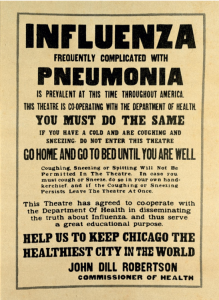Widgetized Section
Go to Admin » Appearance » Widgets » and move Gabfire Widget: Social into that MastheadOverlay zone
Flu Fighters: Public Service Heroes
The views expressed are those of the author and do not necessarily reflect the views of ASPA as an organization.
By Robert Brescia
March 21, 2020
It’s not the rock band; they are the, “Foo Fighters.” The current virus pandemic is at the very top of the news cycle. Americans have stocked up on household essentials, are wearing masks and are scavenging for scarce hand sanitizing products. This virus is called SARS-CoV-2, a combination of Severe Acute Respiratory Syndrome (SARS) caused by a coronavirus, (CoV). It’s also referred to by the disease that it causes—coronavirus disease 2019, or COVID19. Regardless of how one refers to it, it is a very dangerous virus, primarily because it mutates and spreads. In this article, we discuss the federal and state efforts, often linked and aligned, to combat this scourge and put it behind us. Disclaimer: I’m a social scientist, not a biologist, so I’m focusing on government efforts to stop the spread of the virus. Secondly, the coronavirus landscape changes daily so this is somewhat of a snapshot in time.
The Historical Backdrop

Like most current events, however, we can look back into history to better understand our present challenges. After all, the great philosopher and historian Will Durant, said, “The past is the present, all unfurled for analysis; the present is the past, all ready for action!” Let’s begin therefore, with a historical perspective. During 1918-19, the Spanish flu spread throughout the world. Nearly 100 million deaths were attributed to it, making it one of the worst virus influenza pandemics ever known. A third of the world’s population became infected. It was an influenza type A virus known as H1N1; nothing to do with Spain at all. This was a true pandemic. The Spanish flu spread like wildfire, attacking not only the very young and the very old, but adults of every age. High fever and shortness of breath were distinct symptoms, as well as severe vomiting and nosebleeds. In many cases, health officials tagged these deaths as pneumonia because they could not do otherwise under the tight wartime censoring of the press. Spain was a neutral nation during World War I so it had the most media coverage of the disease—which resulted in the name Spanish flu. The generally accepted origins of that pandemic were a genetic mutation in China.
An epidemic is a sudden disease outbreak that affects many people in a finite region or area. A pandemic happens when an epidemic spreads across continents. The official numbers reveal over 100,000 cases of COVID-19 in almost 100 countries. Regardless of what politicians may label it, public health officials have rightfully referred to it as a pandemic.
Public Service to the Rescue
Flu fighting is a great example of federal-state cooperation. Here in Texas for example, we have ten state laboratories that are currently researching the Corona virus. We have also ramped up the capacity of testing centers as well. The University of Texas Medical Branch in Galveston operates a high security biocontainment lab where scientists are working on both a vaccine for coronavirus and a treatment. In 1997 a public health mission to Alaska took place to find and examine victims of the Spanish flu. Genetic samples were taken from a woman found under the permafrost in a mass grave. This added to our collective knowledge of how flu viruses mutate and spread. The research efforts of the World Health Organization (WHO) and the Centers for Disease Control and Prevention (CDCP) benefit greatly from these advances. The CDC has also grown the COVID-19 virus in cell culture and has provided it to the National Institute of Health (NIH). It is also developing a serology test for COVID-19. The National Institute of Allergy and Infectious Diseases (NIAID), part of the National Institutes of Health, is sponsoring a clinical trial to evaluate an experimental treatment for COVID-19 called remdesivir. The actual trial, involving a volunteer American who was quarantined on the Diamond Princess cruise ship that docked in Yokohama, Japan, is being conducted by the University of Nebraska Medical Center (UNMC). New drugs are forthcoming to try and halt the spread of the current pandemic but as always, improved public hygiene remains the key to individual protection against the flu—handwashing is simple and highly effective, as well as unnecessary social gathering.
Thank You, Public Service Heroes
All these actions and initiatives at the various levels of our federal and state governments, as well as the cooperation with university research centers, shows once again why we are the world leader in safeguarding our citizenry. The administrators and scientists as well as all the hard-working university professors constitute a superstar team of public service heroes. They operate behind the scenes, often cloaked in secrecy by necessity, and don’t receive the accolades they should for their hard work. We want to say thank you to these heroes who engender to discover cures and preventive measures against diseases that could otherwise severely affect many of us.
Author: Dr. Robert Brescia is a senior executive with service to the nation in military, business, and education sectors. He respects the wisdom of generations and promotes the thrill of learning. Bob’s latest book is Destination Greatness – Creating a New Americanism. Bob has a doctoral degree with distinction in Executive Leadership from The George Washington University. Please contact him at [email protected].


Christopher John Stanley
March 22, 2020 at 6:38 pm
Thanks! Dr. B…Alway good to hear a measured response on the issues of the day!!
Richard Battle
March 22, 2020 at 5:17 pm
Another terrific contribution by Dr. Brescia to the community of thinkers.
It is extremely valuable to recall the past in dealing with our present challenge.
Thanks Dr. Brescia!